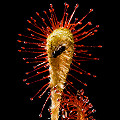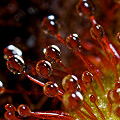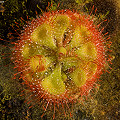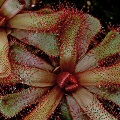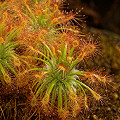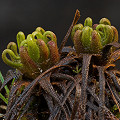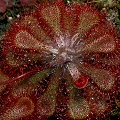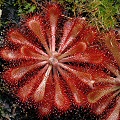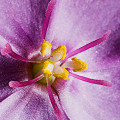Q: Introduction to the sundews (Drosera)
A:Sundews are sticky flypaper plants. They bear long tentacles on their
leaves, and these stalks are tipped with glands which are often brightly coloured. The glands exude attractive nectar,
adhesive compounds, and digestive enzymes. Insects that land on the leaves stick fast and are
digested. Often nearby glandular tentacles are stimulated and also adhere to
the insect, and on many species the entire leaf coils around the prey.
These motions are usually slow, taking minutes or hours to occur. An often overlooked aspect of tentacle motion is the fact
that a tentacle can bend in just about any direction. But when a bug is caught on a leaf, all the tentacles
know the direction to bend towards. That's pretty cool. Scientists wonder how it is done.
In some species, (for example D. burmannii), the tentacle motion is faster--some of the glands can bend
180° in just tens of seconds. Meanwhile, the tentacles of the "snap-trap"
D. glanduligera move so fast they essentially fling prey into the trap center!
There are hundreds of species of
Drosera species described, and they are found in terrestrial habitats
on every continent except Antarctica. The diversity of forms in this genus is
amazing. Some tropical forms grow year-round, while others die back
to fleshy roots (some even hide in little potato-like corms during the dry season). Species
from cold, snowy habitats often spend the winter solstice season curled up in
densely packed buds called hibernacula. Some species are tall, erect or viney
plants, others are ground-hugging rosettes.
Other than the usual problems associated with habitat destruction, the species with large ranges do not have any really serious conservation threats.
Oh, sure, I know of many, many places that once had Drosera but which have been destroyed for land development.
This can crushingly painful to watch, but the impact to widespread species is usually not too bad.
In contrast, species that have small ranges can be seriously affected by even a small amount of land destruction.
Some pygmy Drosera in Western Australia, for example, have very small ranges. A single
shopping mall could mean the end of a species!
No doubt climate change, and associated changes in rainfall and hydrology, could be devastating for even species with large ranges. We shall see, won't we?
In the next several pages, I will discuss all the species of Drosera, using categories similar to
the ones I used in my book. If you are searching for a list of every species in the genus, or a discussion of the sections in the genus, I
have that at the end of my Drosera treatment. Enjoy!
A quick comment on cultivation before we head off to the next page. As you would expect for a genus with so many types of plants,
there is no single prescription for how to grow them all. You must know the kind of plant you have in order to know how to grow it.
But if you have a first-time plant, it is probably one of the species that is very easy to grow, like
D. capensis, D. capillaris, D. dielsiana or D. spatulata.
Your main task will be to give such a plant enough light, as you will see.
Page citations: D'Amato, P. 1998a; Davion, R. 2005, pers. communication;
Juniper, B.E. et al. 1989; Lowrie, A. 1987, 1989, 1999, 2013; Lowrie, A. et al. 2017a, 2017b;
Rice, B.A. 2006a; Robinson, A. et al. 2017; Schlauer, J. 2002; personal
observations.
